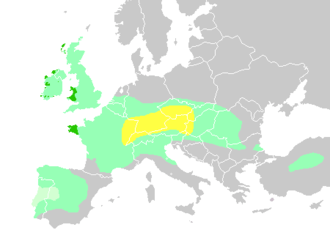Pre-Celtic
The pre-Celtic period in the prehistory of Central and Western Europe occurred before the expansion of the Celts or their culture in Iron Age Europe and Anatolia (9th to 6th centuries BC), but after the emergence of the Proto-Celtic language and cultures. The area involved is that of the maximum extent of the Celtic languages in about the mid 1st century BC. The extent to which Celtic language, culture and genetics coincided and interacted during this period remains very uncertain and controversial.

Languages
Proto-Celtic is mainly dated to approximately 800 BC, coincident with the Hallstatt culture, while the earliest possible divergence of pre-proto-Celtic dialects from Proto-Indo-European is mainly dated to between 3000 BC and 2000 BC.
In continental Europe, pre-Celtic languages of the European Bronze Age may be taken to comprise two distinct groups.
- Non-Indo-European languages (i.e. Pre-Indo-European languages); these include Basque,[1][2] Rhaetic, Etruscan,[3] Iberian, which may be related to Basque but is still unclassified, Aquitanian and Paleo-Sardinian. Some scholars group Etruscan, Rhaetic and Lemnian together in the hypothetical Tyrrhenian language family, which may have originated in the Aegean Sea or during the Neolithic north of the Alps.[4][5][6][7] Conversely, the Lemnian language could have arrived in the Aegean Sea during the Late Bronze Age, when Mycenaean rulers recruited groups of mercenaries from Sicily, Sardinia and various parts of the Italian peninsula.[8]
- Indo-European dialects, such as Illyrian, possibly Lusitanian, the Proto-Italo-Celtic dialects, Belgian and "Old European".[9] However, Lusitanian and Belgian can turn out to be Celtic, while Old European can turn out to be either Celtic or non-Indo-European. The very existence of Indo-European in Western Europe before the arrival of the Celts is highly speculative.
It has been suggested that results of large-scale genetic surveys, undertaken since the late 20th century, show that the present-day speakers of pre-Indo-European languages may not solely represent relict populations. For instance, Basques show a dominance of the Y-DNA Haplogroup R1b,[10] which a majority of scholars now propose spread through Europe relatively recently, from the Eurasian steppe and/or southwest Asia in the late Neolithic period or early Bronze Age (4,000 to 8,000 years ago).[11][10][12][13][14][15] (R1a, rather than R1b is a better candidate for Indo-European, however. It should also be mentioned that R1b quite quickly annihilated all indigenous male lineages in Iberia.) However, present-day Basques also harbour some very rare and archaic lineages, such as the Paleolithic mitochondrial DNA Haplogroup U8a, and autosomal genetic analysis (the whole genome, not just Y-DNA) has shown that a majority of their ancestry derives from Neolithic farmers and Mesolithic hunter-gatherers, pre-dating the arrival of speakers of Indo-European languages.[11][16][17][18]
Archaeology
In the later Celtic areas there were many disparate archaeological cultures.
History
When the Celts were first recorded about 600 BC, they were already widespread across Iberia, Gaul, and Central Europe.
In Ireland, the Book of Invasions gives a legendary account of the arrival of incoming peoples.
See also
- Neolithic Europe
- Old European culture
- Bronze Age Europe
- Old European hydronymy
- Pre-Germanic
- Vasconic substratum hypothesis
- Atlantic (Semitic) languages
- Pre-Roman peoples of the Iberian Peninsula
- Prehistoric Britain
- Bronze Age Britain
- Prehistoric Ireland
- Paleolithic Continuity Theory
- Italo-Celtic
- Goidelic substrate hypothesis
- Magdalenian
References
- Trask, R.L. 1997. The History of Basque. P.9. Citing Bertranpetit and Cavalli-Sforza: "Basques represent descendants of Paleolithic and/or Mesolithic populations and non-Basques later arrivals, beginning with the Neolithic.".
- Hualde, José Ignacio and Jon Ortiz de Urbina. A grammar of Basque. 2003. P.7
- Pallottino, 1955. The Etruscans:
...an ethnic island of very ancient peoples isolated by the flood of Indo-European speakers.
Page 52 - Facchetti, Giulio M. & Negri, Mario. Creta Minoica. Sulle tracce delle più antiche scritture d'Europa. Leo S. Olschki Editore, 'Biblioteca dell'Archivum Romanicum. Serie II: Linguistica' nº 55, 2003. ISBN 8822252918.
- Bonfante, Larissa (1990). Etruscan. Berkeley and Los Angeles: University of California Press. ISBN 978-0-520-07118-6.
- de Simone, Carlo (2009). "La nuova iscrizione tirsenica di Efestia". Tripodes. 11. pp. 3–58.
- Steinbauer, Dieter H. (1999). Neues Handbuch des Etruskischen. St. Katharinen: Scripta Mercaturae Verlag.
- De Ligt, Luuk (2008–2009). "An 'Eteocretan' Inscription from Praisos and The Homeland of The Sea Peoples" (PDF). Talanta. XL-XLI: 151–172.CS1 maint: date format (link)
- Kitson, P.R. (November 1996). "British and European River Names". Transactions of the Philological Society. 94 (2): 73–118. doi:10.1111/j.1467-968X.1996.tb01178.x.
- Balaresque, Patricia; Bowden, Georgina R.; Adams, Susan M.; Leung, Ho-Yee; King, Turi E.; et al. (2010). Penny, David (ed.). "A Predominantly Neolithic Origin for European Paternal Lineages". PLOS Biology. Public Library of Science. 8 (1): e1000285. doi:10.1371/journal.pbio.1000285. PMC 2799514. PMID 20087410.
- Haak, Wolfgang; Lazaridis, Iosif; Patterson, Nick; Rohland, Nadin; Mallick, Swapan; Llamas, Bastien; Brandt, Guido; Nordenfelt, Susanne; Harney, Eadaoin; Stewardson, Kristin; Fu, Qiaomei; Mittnik, Alissa; Bánffy, Eszter; Economou, Christos; Francken, Michael; Friederich, Susanne; Pena, Rafael Garrido; Hallgren, Fredrik; Khartanovich, Valery; Khokhlov, Aleksandr; Kunst, Michael; Kuznetsov, Pavel; Meller, Harald; Mochalov, Oleg; Moiseyev, Vayacheslav; Nicklisch, Nicole; Pichler, Sandra L.; Risch, Roberto; Rojo Guerra, Manuel A.; et al. (2015). "Massive migration from the steppe is a source for Indo-European languages in Europe". Nature. 522 (7555): 013433. arXiv:1502.02783. Bibcode:2015Natur.522..207H. bioRxiv 10.1101/013433. doi:10.1038/NATURE14317. PMC 5048219. PMID 25731166.
- "International Society of Genetic Genealogy (ISOGG) - Y-DNA Haplogroup R and its Subclades". ISOGG. Retrieved 2010-08-22.
- B. Arredi, E.S. Poloni and C. Tyler-Smith, The Peopling of Europe, in M. Crawford (ed.) Anthropological Genetics: Theory, Methods and Applications (Cambridge University Press 2007)
- Myres, Natalie; Rootsi, Siiri; Lin, Alice A; Järve, Mari; King, Roy J; Kutuev, Ildus; Cabrera, Vicente M; Khusnutdinova, Elza K; et al. (2010). "A major Y-chromosome haplogroup R1b Holocene effect in Central and Western Europe". European Journal of Human Genetics. 19 (1): 95–101. doi:10.1038/ejhg.2010.146. PMC 3039512. PMID 20736979.
- Sjödin, Per; François, Olivier (2011). Lalueza-Fox, Carles (ed.). "Wave-of-Advance Models of the Diffusion of the Y Chromosome Haplogroup R1b1b2 in Europe". PLoS ONE. 6 (6:e21592): e21592. Bibcode:2011PLoSO...621592S. doi:10.1371/journal.pone.0021592. PMC 3123369. PMID 21720564.
- Allentoft, Morten E.; Sikora, Martin; Sjögren, Karl-Göran; Rasmussen, Simon; Rasmussen, Morten; Stenderup, Jesper; Damgaard, Peter B.; Schroeder, Hannes; Ahlström, Torbjörn; Vinner, Lasse; Malaspinas, Anna-Sapfo; Margaryan, Ashot; Higham, Tom; Chivall, David; Lynnerup, Niels; Harvig, Lise; Baron, Justyna; Casa, Philippe Della; Dąbrowski, Paweł; Duffy, Paul R.; Ebel, Alexander V.; Epimakhov, Andrey; Frei, Karin; Furmanek, Mirosław; Gralak, Tomasz; Gromov, Andrey; Gronkiewicz, Stanisław; Grupe, Gisela; Hajdu, Tamás; et al. (2015). "Population genomics of Bronze Age Eurasia". Nature. 522 (7555): 167–172. Bibcode:2015Natur.522..167A. doi:10.1038/nature14507. PMID 26062507.
- Mathieson, Iain; Lazaridis, Iosif; Rohland, Nadin; Mallick, Swapan; Patterson, Nick; Alpaslan Roodenberg, Songul; Harney, Eadaoin; Stewardson, Kristin; Fernandes, Daniel; Novak, Mario; Sirak, Kendra; Gamba, Cristina; Jones, Eppie R.; Llamas, Bastien; Dryomov, Stanislav; Pickrell, Joseph; Arsuaga, Juan Luis; De Castro, Jose Maria Bermudez; Carbonell, Eudald; Gerritsen, Fokke; Khokhlov, Aleksandr; Kuznetsov, Pavel; Lozano, Marina; Meller, Harald; Mochalov, Oleg; Moiseyev, Vayacheslav; Rojo Guerra, Manuel A.; Roodenberg, Jacob; Verges, Josep Maria; et al. (2015). "Eight thousand years of natural selection in Europe". bioRxiv: 016477. doi:10.1101/016477.
- González, AM; García, O; Larruga, JM; Cabrera, VM (2006). "The mitochondrial lineage U8a reveals a Paleolithic settlement in the Basque country". BMC Genomics. 7: 124. doi:10.1186/1471-2164-7-124. PMC 1523212. PMID 16719915.
Bibliography
- Thompson, T. Ireland's Pre-Celtic Archaeological and Anthropological Heritage. (2006) Edwin Mellen Press.
- Waddell, J., The Celticization of the West: an Irish Perspective, in C. Chevillot and A. Coffyn (eds), L' Age du Bronze Atlantique. Actes du 1er Colloque de Beynac, Beynac (1991), 349-366.
- Waddell, J.,The Question of the Celticization of Ireland, Emania No. 9 (1991), 5-16.
- Waddell, J., 'Celts, Celticisation and the Irish Bronze Age', in J. Waddell and E. Shee Twohig (eds.), Ireland in the Bronze Age. Proceedings of the Dublin Conference, April 1995, 158-169.
